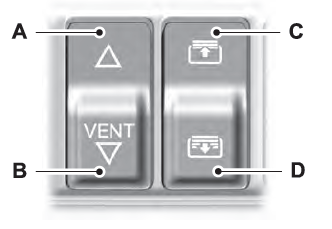Lincoln Aviator: Windows and Mirrors / Moonroof (If Equipped)
WARNING: Do not leave children unattended in your vehicle and do not let them play with the moonroof. Failure to follow this instruction could result in personal injury.
WARNING: When closing the moonroof, verify that it is free of obstruction and make sure that children and pets are not in the proximity of the roof opening.
The moonroof controls are on the overhead console and have a one-touch open and close feature. To stop it during one-touch operation, press the control a second time.
Opening and Closing the Moonroof

- Moonroof open. Press and release to open the moonroof.
- Moonroof vent or close. Press and release to vent or close the moonroof.
- Sunshade open. Press and release to open the sunshade. The sunshade opens with the moonroof. You can also manually open the sunshade with the moonroof closed.
- Sunshade close. Press and release to close the sunshade.
Note: The sunshade stops short of the fully open position for the comfort of rear passengers. To fully open the sunshade, press the control again.
Note: When closing, the sunshade stops at the first panel for the dual panel moonroof. Press and release again to continue to fully close the sunshade.
Rear SunShade Opening and Closing (If Equipped)

- Sunshade close. Press and release to close the sunshade.
- Sunshade open. Press and release to open the sunshade. The sunshade opens with the moonroof. You can also manually open the sunshade with the moonroof closed.
Note: The rear sunshade open and close controls can be on the rear console or fold down armrest bezel.
Note: The sunshade stops short of its fully opened position for the comfort of rear passengers. To fully open the sunshade, press the control again.
Bounce-Back
The moonroof reverses some distance if it detects an obstacle when closing.
To override this feature, press and hold the moonroof close control within two seconds after the roof comes to a stop following a bounce-back reversal.
 Sun Visors
Sun Visors
..
Other information:
Lincoln Aviator 2020-2025 Owners Manual: Declaration of Conformity - Vehicles With: SYNC 3
Radio Frequency Statement WARNING: Changes or modifications not expressively approved by the party responsible for compliance could void the user's authority to operate the equipment. The term "IC:" before the radio certification number only signifies that Industry Canada technical specifications were met...
Lincoln Aviator 2020-2025 Owners Manual: Information Contained on the Tire Sidewall. Information on P Type Tires
Information Contained on the Tire Sidewall Both United States and Canada Federal regulations require tire manufacturers to place standardized information on the sidewall of all tires. This information identifies and describes the fundamental characteristics of the tire and also provides a U...
Categories
- Manuals Home
- Lincoln Aviator Owners Manual
- Lincoln Aviator Service Manual
- Keyless Entry
- Description and Operation - Body and Frame
- Remove and Reinstall the Battery
- New on site
- Most important about car
Children and Airbags
WARNING: Airbags can kill or injure a child in a child restraint. Never place a rear-facing child restraint in front of an active airbag. If you must use a forward-facing child restraint in the front seat, move the seat upon which the child restraint is installed all the way back.


